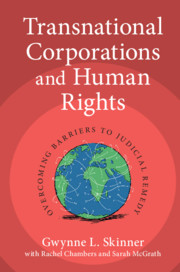Book contents
- Transnational Corporations and Human Rights
- Transnational Corporations and Human Rights
- Copyright page
- Dedication
- Dedication
- Contents
- Foreword
- Abbreviations
- Table of Cases
- Table of Statutes
- Introduction
- Part I Rise of Transnational Corporations, Impact on Human Rights, And Victims’ Rights to Remedy
- 1 Growth and Structure of TNCs
- 2 Victims’ Rights To Remedy for Business-Related Human Rights Violations
- 3 Barriers to Judicial Remedies in Host Countries
- 4 Limits on Subject Matter Jurisdiction over International Human Rights Violations
- 5 Limited Liability of Parent Corporations
- 6 Lack of In Personam Jurisdiction over TNCs and their Affiliates
- Part II Legal Barriers to Remedy and How to Overcome Them
- Conclusion
- Select Bibliography
- Index
5 - Limited Liability of Parent Corporations
from Part I - Rise of Transnational Corporations, Impact on Human Rights, And Victims’ Rights to Remedy
Published online by Cambridge University Press: 04 September 2020
- Transnational Corporations and Human Rights
- Transnational Corporations and Human Rights
- Copyright page
- Dedication
- Dedication
- Contents
- Foreword
- Abbreviations
- Table of Cases
- Table of Statutes
- Introduction
- Part I Rise of Transnational Corporations, Impact on Human Rights, And Victims’ Rights to Remedy
- 1 Growth and Structure of TNCs
- 2 Victims’ Rights To Remedy for Business-Related Human Rights Violations
- 3 Barriers to Judicial Remedies in Host Countries
- 4 Limits on Subject Matter Jurisdiction over International Human Rights Violations
- 5 Limited Liability of Parent Corporations
- 6 Lack of In Personam Jurisdiction over TNCs and their Affiliates
- Part II Legal Barriers to Remedy and How to Overcome Them
- Conclusion
- Select Bibliography
- Index
Summary
There are multiple obstacles to accessing judicial remedies for transnational harms, all of which combine to make access to justice for victims of human rights violations by TNCs exceptionally difficult and frequently impossible. The twin principles of separate legal personality and limited liability, together with limitations on extraterritorial jurisdiction and the evidentiary burdens of bringing a claim, are major barriers that victims encounter. While each issue plays an important role in denying victims a chance of obtaining access to remedy, the complex corporate structures that characterize the organization of modern business are at the heart of these obstacles. In the absence of legislation clarifying standards for parent company liability, victims face an enormous challenge to demonstrate how a parent company of a multinational enterprise, domiciled in the home state, bears responsibility for the harm carried out by its subsidiary in the host state.
- Type
- Chapter
- Information
- Transnational Corporations and Human RightsOvercoming Barriers to Judicial Remedy, pp. 43 - 51Publisher: Cambridge University PressPrint publication year: 2020

